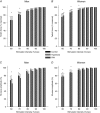Exercise-induced quadriceps muscle fatigue in men and women: effects of arterial oxygen content and respiratory muscle work
- PMID: 28524229
- PMCID: PMC5538269
- DOI: 10.1113/JP274068
Exercise-induced quadriceps muscle fatigue in men and women: effects of arterial oxygen content and respiratory muscle work
Abstract
Key points: High work of breathing and exercise-induced arterial hypoxaemia (EIAH) can decrease O2 delivery and exacerbate exercise-induced quadriceps fatigue in healthy men. Women have a higher work of breathing during exercise, dedicate a greater fraction of whole-body V̇O2 towards their respiratory muscles and develop EIAH. Despite a greater reduction in men's work of breathing, the attenuation of quadriceps fatigue was similar between the sexes. The degree of EIAH was similar between sexes, and regardless of sex, those who developed the greatest hypoxaemia during exercise demonstrated the most attenuation of quadriceps fatigue. Based on our previous finding that women have a greater relative oxygen cost of breathing, women appear to be especially susceptible to work of breathing-related changes in quadriceps muscle fatigue.
Abstract: Reducing the work of breathing or eliminating exercise-induced arterial hypoxaemia (EIAH) during exercise decreases the severity of quadriceps fatigue in men. Women have a greater work of breathing during exercise, dedicate a greater fraction of whole-body V̇O2 towards their respiratory muscles, and demonstrate EIAH, suggesting women may be especially susceptible to quadriceps fatigue. Healthy subjects (8 male, 8 female) completed three constant load exercise tests over 4 days. During the first (control) test, subjects exercised at ∼85% of maximum while arterial blood gases and work of breathing were assessed. Subsequent constant load exercise tests were iso-time and iso-work rate, but with EIAH prevented by inspiring hyperoxic gas or work of breathing reduced via a proportional assist ventilator (PAV). Quadriceps fatigue was assessed by measuring force in response to femoral nerve stimulation. For both sexes, quadriceps force was equally reduced after the control trial (-27 ± 2% baseline) and was attenuated with hyperoxia and PAV (-18 ± 1 and -17 ± 2% baseline, P < 0.01, respectively), with no sex difference. EIAH was similar between the sexes, and regardless of sex, subjects with the lowest oxyhaemoglobin saturation during the control test had the greatest quadriceps fatigue attenuation with hyperoxia (r2 = 0.79, P < 0.0001). For the PAV trial, despite reducing the work of breathing to a greater degree in men (men: 60 ± 5, women: 75 ± 6% control, P < 0.05), the attenuation of quadriceps fatigue was similar between the sexes (36 ± 4 vs. 37 ± 7%). Owing to a greater relative V̇O2 of the respiratory muscles in women, less of a change in work of breathing is needed to reduce quadriceps fatigue.
Keywords: hypoxaemia; oxygen delivery; work of breathing.
© 2017 The Authors. The Journal of Physiology © 2017 The Physiological Society.
Figures







Similar articles
-
Effect of exercise-induced arterial hypoxemia on quadriceps muscle fatigue in healthy humans.Am J Physiol Regul Integr Comp Physiol. 2006 Feb;290(2):R365-75. doi: 10.1152/ajpregu.00332.2005. Epub 2005 Sep 15. Am J Physiol Regul Integr Comp Physiol. 2006. PMID: 16166208 Clinical Trial.
-
Effects of hypoxia on diaphragmatic fatigue in highly trained athletes.J Physiol. 2007 May 15;581(Pt 1):299-308. doi: 10.1113/jphysiol.2006.126136. Epub 2007 Feb 22. J Physiol. 2007. PMID: 17317748 Free PMC article. Clinical Trial.
-
Exercise-induced arterial hypoxaemia and the mechanics of breathing in healthy young women.J Physiol. 2013 Jun 15;591(12):3017-34. doi: 10.1113/jphysiol.2013.252767. Epub 2013 Apr 15. J Physiol. 2013. PMID: 23587886 Free PMC article.
-
Exercise-induced arterial hypoxaemia in active young women.Appl Physiol Nutr Metab. 2007 Dec;32(6):1263-73. doi: 10.1139/H07-122. Appl Physiol Nutr Metab. 2007. PMID: 18059604 Review.
-
Respiratory muscle fatigue during exercise: implications for performance.Med Sci Sports Exerc. 1996 Sep;28(9):1129-37. doi: 10.1097/00005768-199609000-00008. Med Sci Sports Exerc. 1996. PMID: 8883000 Review.
Cited by
-
The Effect of Hyperoxia on Central and Peripheral Factors of Arm Flexor Muscles Fatigue Following Maximal Ergometer Rowing in Men.Front Physiol. 2022 Feb 3;13:829097. doi: 10.3389/fphys.2022.829097. eCollection 2022. Front Physiol. 2022. PMID: 35185623 Free PMC article.
-
An integrative approach to the pulmonary physiology of exercise: when does biological sex matter?Eur J Appl Physiol. 2021 Sep;121(9):2377-2391. doi: 10.1007/s00421-021-04690-9. Epub 2021 Apr 27. Eur J Appl Physiol. 2021. PMID: 33903937 Review.
-
Comprehensive evaluation of military training-induced fatigue among soldiers in China: A Delphi consensus study.Front Public Health. 2022 Nov 29;10:1004910. doi: 10.3389/fpubh.2022.1004910. eCollection 2022. Front Public Health. 2022. PMID: 36523578 Free PMC article.
-
The independent effects of age and sex in performance fatigability profile after a ramp incremental cycling test.Eur J Appl Physiol. 2025 Jun 4. doi: 10.1007/s00421-025-05823-0. Online ahead of print. Eur J Appl Physiol. 2025. PMID: 40464958
-
Breathing a low-density gas reduces respiratory muscle force development and marginally improves exercise performance in master athletes.Eur J Appl Physiol. 2024 Feb;124(2):651-665. doi: 10.1007/s00421-023-05346-6. Epub 2023 Nov 17. Eur J Appl Physiol. 2024. PMID: 37973652
References
-
- Aaron EA, Johnson BD, Seow CK & Dempsey JA (1992a). Oxygen cost of exercise hyperpnea: measurement. J Appl Physiol 72, 1810–1817. - PubMed
-
- Aaron EA, Seow KC, Johnson BD & Dempsey JA (1992b). Oxygen cost of exercise hyperpnea: implications for performance. J Appl Physiol 72, 1818–1825. - PubMed
-
- Adams RP & Welch HG (1980). Oxygen uptake, acid‐base status, and performance with varied inspired oxygen fractions. J Appl Physiol 49, 863–868. - PubMed
-
- Amann M & Calbet JAL (2008). Convective oxygen transport and fatigue. J Appl Physiol 104, 861–870. - PubMed
-
- Amann M, Pegelow DF, Jacques AJ & Dempsey JA (2007). Inspiratory muscle work in acute hypoxia influences locomotor muscle fatigue and exercise performance of healthy humans. Am J Physiol Regul Integr Comp Physiol 293, R2036–R2045. - PubMed
Publication types
MeSH terms
Substances
LinkOut - more resources
Full Text Sources
Other Literature Sources
Medical

